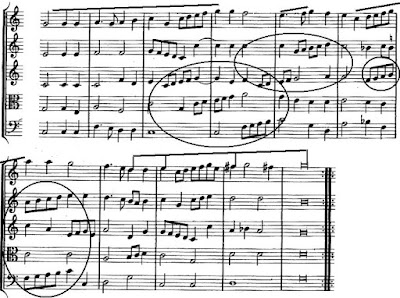Another selection from the many courantes in
Terpsichore. All but one are in two sections. Here the focus is on the second strain where the upper range, usually ^5-^8 in the mode of the final, is reached early and then its top is either maintained to the end or, more likely, the music drops to the lower end of the range, to move upward again in the cadence.
n38: The lower fifth of the Aeolian octave is presented immediately (arrow plus circled E5), then inverted two bars later to the upper fourth E5-A5, within which a clear descent is followed by a quick ascent to the cadence. Note, incidentally, that the courantes do use hemiolas but only very rarely have suspension dissonances in the cadence, in keeping with the simplicity and directness (and perhaps the rapid tempo) of the popular dance these musics served.
n41: Once A5 is reached in the cadence of the first strain, it is held throughout the abbreviated second strain (only 6 bars, as shown, or more in the manner of a coda or refrain than a separate strain).
n75: The registral patterning of the melody in the second strain is analyzed below. The score is given under that for reference. At (a), a full triad outline (upper bracket) that persists (lower bracket), then at (b) an abrupt shift upward to D5-A5; at (c) a slight settling back to C5-G5, or as it goes on, really D5-G5, which is filled with a line (at c2) to reach the cadence.

(score for n75)
n104: A shift to minor quality in the second strain, with a fairly leisurely descent/ascent pair that use both F# and F-natural in each half of the figure.
n110: A courante with just one strain. The pattern is similar to that in n75: a triad outline to start, an abrupt transposition of the framing interval, and a cadence. Here the initial triad is also G major, and the second is D major but lower (fourth octave) not higher as in n75; the cadence is to D rather than G, and the ascending line is clear and direct.
n111: The first strain has features very similar to those of n110, but the space A4-D5 is emphasized almost immediately, and it is the D major triad that is elaborated by bars 2-3. The ascent to the cadence is only marginally longer (3 bars rather than 2 1/2) but is full of diminutions.
In the second strain the D major triad frame is even more obvious (box), and there is a descent/ascent linear pair leading to the cadence. (The opening on G and close on D reflects a pattern that is not uncommon in the Mixolydian mode, the mode with a G final that is here transposed to D, requiring the one-sharp signature.)


















































